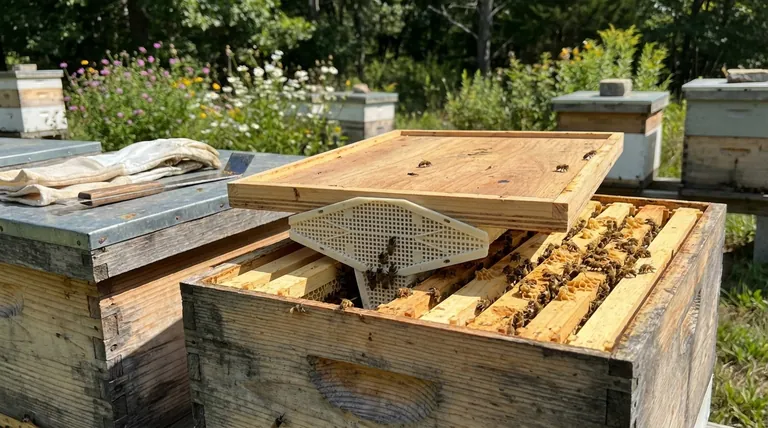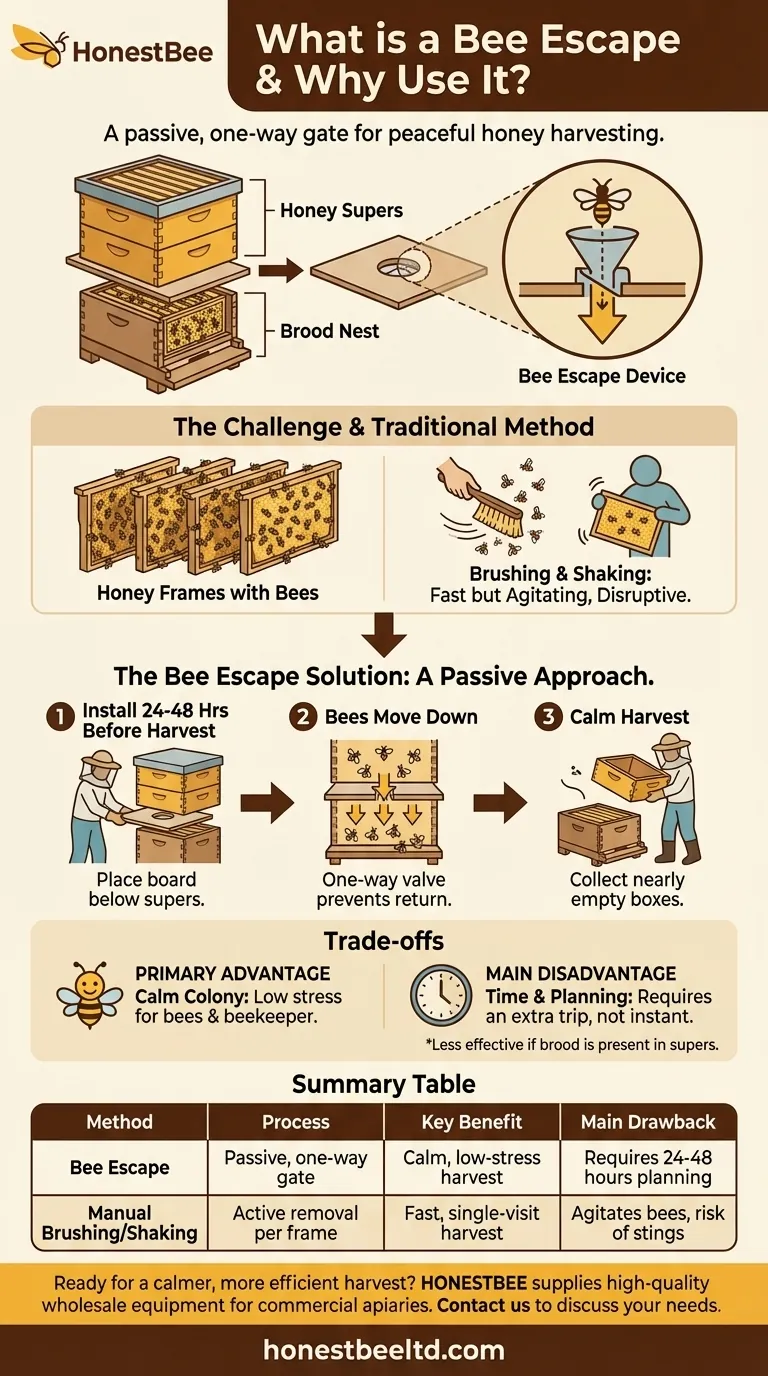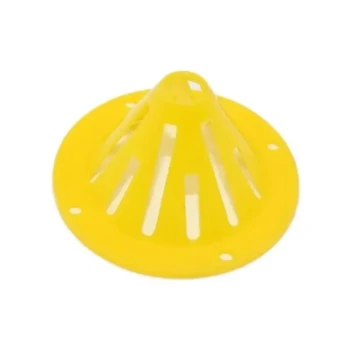In short, a bee escape is a one-way gate for honeybees. It is a simple beekeeping tool designed to clear bees out of a honey super (a box full of harvestable honey) without harming or agitating them. By installing a board with a bee escape between the honey supers and the main hive body, beekeepers can return a day later to find the honey boxes nearly empty and ready for a peaceful harvest.
A bee escape solves one of the beekeeper's core challenges: how to gently and efficiently separate the bees from the honey you want to collect. It automates the process, prioritizing the colony's well-being over the speed of manual removal.

The Challenge: A Box Full of Bees and Honey
Before a honey harvest, the honeycombs you want to take are covered in thousands of worker bees. The beekeeper's task is to remove these bees so the frames of honey can be taken away for extraction.
The Traditional Method: Brushing and Shaking
The most direct way to remove bees is to take each frame out, shake it vigorously over the hive, and use a special bee brush to sweep off any remaining bees.
This method is fast and effective. However, it can be highly disruptive and agitating to the colony, increasing the chance of stings and general stress on the hive.
The Bee Escape Solution: A Passive Approach
A bee escape offers a completely different, passive strategy. It is typically a small plastic or metal device installed in the center of a solid board (an "inner cover").
The escape itself has a one-way valve or a maze-like design. Bees can easily travel through it in one direction—down toward the main brood nest—but cannot figure out how to get back through in the opposite direction.
The Standard Workflow
The process is straightforward. A beekeeper visits the hive 24 to 48 hours before the planned harvest.
They place the bee escape board directly underneath the honey supers they intend to harvest. The natural tendency of the bees to move down into the main part of the hive at night means they will gradually leave the honey supers through the one-way gate, but they will be unable to return.
Understanding the Trade-offs
Using a bee escape is a strategic choice with clear benefits and a significant drawback compared to other methods. Understanding these trade-offs is key to using the tool effectively.
The Primary Advantage: A Calm Colony
The greatest benefit is the reduction in stress for both the bees and the beekeeper. The harvest becomes a quiet, calm process of simply lifting off nearly empty boxes of honey. There is no shaking, brushing, or defensive behavior from the colony.
The Main Disadvantage: Time and Planning
The most significant downside is time. This method is not instant. It requires an extra trip to the apiary—one to install the escape and another a day or two later to collect the honey. This makes it less suitable for beekeepers who need to harvest on a tight schedule or manage many hives in distant locations.
When an Escape Might Not Work
A bee escape is less effective if there is brood (bee larvae) present in the honey supers. Nurse bees will not abandon the brood, so they will not "escape" down into the main hive, defeating the purpose of the tool.
Making the Right Choice for Your Harvest
Ultimately, the decision to use a bee escape depends on your beekeeping philosophy and logistical constraints.
- If your primary focus is a gentle, low-stress harvest: The bee escape is the ideal tool, provided you can plan for the extra trip to your apiary.
- If your primary focus is speed and efficiency: Manually brushing or shaking frames is a faster method for getting the honey off the hive in a single visit.
Choosing the right tool is about aligning your methods with your goals, and the bee escape is the perfect choice for the patient beekeeper who prioritizes a calm hive.
Summary Table:
| Method | Process | Key Benefit | Main Drawback |
|---|---|---|---|
| Bee Escape | Passive, one-way gate | Calm, low-stress harvest | Requires 24-48 hours of planning |
| Manual Brushing/Shaking | Active removal per frame | Fast, single-visit harvest | Agitates bees, higher risk of stings |
Ready to achieve a calmer, more efficient harvest?
As a beekeeper, you know that the right equipment makes all the difference. HONESTBEE supplies commercial apiaries and beekeeping equipment distributors with high-quality, durable beekeeping supplies through our wholesale-focused operations.
Let us help you equip your operation for success. Contact HONESTBEE today to discuss your wholesale needs and discover how our reliable tools can support your hive management goals.
Visual Guide

Related Products
- High-Efficiency Diamond Maze Bee Escape for Clearing Supers
- Circular Labyrinth Bee Escape for Efficient Hive Management
- HONESTBEE Multi Exit Plastic Bee Escape Board for Efficient Honey Harvesting
- Professional Durable Two-Piece Plastic Bee Escape
- Efficient Hive Clearing: HONESTBEE 8-Way Plastic Bee Escape
People Also Ask
- Where should the triangle escape board be placed in the hive? Master a Gentle, Stress-Free Honey Harvest
- What is the result of using a bee escape board for 24 hours? Achieve a Near Bee-Free Honey Super
- How long should a bee escape be placed before harvesting honey? The 24-48 Hour Guide to a Stress-Free Harvest
- How long should the Bee Escape Board be left on the honey supers? Achieve a Peaceful Harvest in 24 Hours
- What was the result of using the bee escape board? Achieve a Calm, Low-Stress Honey Harvest



















